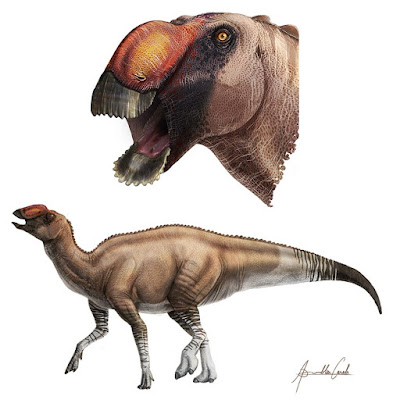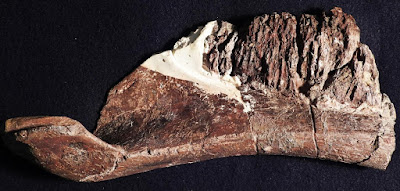[Most Recent Entries] [Calendar View]
Monday, July 15th, 2019
| Time | Event | ||
| 2:25p | [Paleontology • 2019] Aquilarhinus palimentus • An Unusual ‘Shovel-billed’ Dinosaur with Trophic Specializations from the early Campanian of Trans-Pecos Texas, and the Ancestral Hadrosaurian Crest
Abstract We describe a new genus and species of hadrosaurid dinosaur, Aquilarhinus palimentus, from the lower shale member of the Aguja Formation (lower Campanian) of Big Bend National Park, south-western Texas. This species is characterized by several autapomorphies of the facial skeleton and mandible, including a crest composed of broadly arched nasals. Notably, the symphyseal processes of the dentary are elongated and reflected dorsally, causing the dentaries to meet with a ‘W’-shaped anterior profile. A hypothesized shovel-shaped ‘bill’, associated with widening of the skull, in A. palimentus might have been used in shovelling out and scooping up semiaquatic vegetation. This animal is otherwise superficially similar to kritosaurins like Gryposaurus but differs in the retention of key plesiomorphic character states in the maxilla and jugal. Phylogenetic analysis reveals Aquilarhinus to be a non-saurolophid hadrosaurid allied to Latirhinus from the late Campanian of Mexico, which bears a similar broadly arched nasal. The recognition of this lineage adds to the diversity of non-saurolophid hadrosaurids and points to the existence of a hitherto unknown diversity of ‘duck-billed’ dinosaurs outside of the saurolophine-lambeosaurine radiation. Cranial crests were ancestral for early hadrosaurids and evolved before the saurolophid radiation. Ancestrally, crests were ‘solid’, and consisted of arched nasals. These were retained among kritosaurins and subsequently modified into the diverse crest morphologies observed among derived saurolophines. Lambeosaurine ‘hollow-crested’ crest morphology departed from the ancestral, ‘solid-crested’ pre-saurolophid condition early following the origin of that clade. Keywords: Dinosauria, Hadrosauridae, phylogeny, evolution, Cretaceous, North America Systematic palaeontology Dinosauria Owen, 1842 Ornithischia Seeley, 1887 Ornithopoda Marsh, 1881 Iguanodontia Dollo, 1888 Hadrosauridae Cope, 1870 (sensu Prieto-Márquez, 2010) Aquilarhinus gen. nov. Type species. Aquilarhinus palimentus sp. nov. Etymology. From the Latin ‘aquila’, meaning ‘eagle’, and the Greek ‘rhinos’, meaning ‘nose’. The combination of these two words references the morphology of the rostrum. Aquilarhinus palimentus sp. nov. Kritosaurus sp. nov. Wagner, 2001; Wagner & Lehman, 2001 Etymology. The specific name is a combination of the Latin words ‘pala’, shovel, and ‘mentus’, chin, in reference to the assumed resemblance of the predentary to a spade or shovel given the dorsomedial projection of the symphyseal process of the dentary. Albert Prieto-Márquez, Jonathan R. Wagner and Thomas Lehman. 2019. An Unusual ‘Shovel-billed’ Dinosaur with Trophic Specializations from the early Campanian of Trans-Pecos Texas, and the Ancestral Hadrosaurian Crest. Journal of Systematic Palaeontology. DOI: 10.1080/14772019.2019.1625078 Strange new species of duck-billed dinosaur identified phys.org/news/2019-07-strange-species-du |
| << Previous Day |
2019/07/15 [Calendar] |
Next Day >> |



